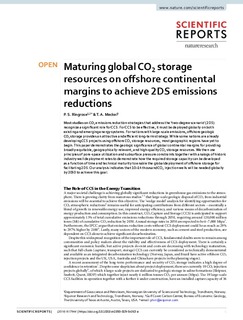| dc.contributor.author | Ringrose, Philip | |
| dc.contributor.author | Meckel, T A | |
| dc.date.accessioned | 2020-02-24T09:38:31Z | |
| dc.date.available | 2020-02-24T09:38:31Z | |
| dc.date.created | 2019-12-01T10:58:48Z | |
| dc.date.issued | 2019 | |
| dc.identifier.citation | Scientific Reports. 2019, 9 (1), 1-10. | nb_NO |
| dc.identifier.issn | 2045-2322 | |
| dc.identifier.uri | http://hdl.handle.net/11250/2643366 | |
| dc.description.abstract | Most studies on CO2 emissions reduction strategies that address the ‘two-degree scenario’ (2DS) recognize a significant role for CCS. For CCS to be effective, it must be deployed globally on both existing and emerging energy systems. For nations with large-scale emissions, offshore geologic CO2 storage provides an attractive and efficient long-term strategy. While some nations are already developing CCS projects using offshore CO2 storage resources, most geographic regions have yet to begin. This paper demonstrates the geologic significance of global continental margins for providing broadly-equitable, geographically-relevant, and high-quality CO2 storage resources. We then use principles of pore-space utilization and subsurface pressure constraints together with analogs of historic industry well deployment rates to demonstrate how the required storage capacity can be developed as a function of time and technical maturity to enable the global deployment of offshore storage for facilitating 2DS. Our analysis indicates that 10–14 thousand CO2 injection wells will be needed globally by 2050 to achieve this goal. | nb_NO |
| dc.language.iso | eng | nb_NO |
| dc.publisher | Nature Research | nb_NO |
| dc.rights | Navngivelse 4.0 Internasjonal | * |
| dc.rights.uri | http://creativecommons.org/licenses/by/4.0/deed.no | * |
| dc.title | Maturing global CO2 storage resources on offshore continental margins to achieve 2DS emissions reductions | nb_NO |
| dc.type | Journal article | nb_NO |
| dc.type | Peer reviewed | nb_NO |
| dc.description.version | publishedVersion | nb_NO |
| dc.source.pagenumber | 1-10 | nb_NO |
| dc.source.volume | 9 | nb_NO |
| dc.source.journal | Scientific Reports | nb_NO |
| dc.source.issue | 1 | nb_NO |
| dc.identifier.doi | 10.1038/s41598-019-54363-z | |
| dc.identifier.cristin | 1755044 | |
| dc.relation.project | Norges forskningsråd: 257579 | nb_NO |
| dc.description.localcode | Open Access This article is licensed under a Creative Commons Attribution 4.0 International License, which permits use, sharing, adaptation, distribution and reproduction in any medium or format, as long as you give appropriate credit to the original author(s) and the source, provide a link to the Creative Commons license, and indicate if changes were made. The images or other third party material in this article are included in the article’s Creative Commons license, unless indicated otherwise in a credit line to the material. If material is not included in the article’s Creative Commons license and your intended use is not permitted by statutory regulation or exceeds the permitted use, you will need to obtain permission directly from the copyright holder. To view a copy of this license, visit http://creativecommons.org/licenses/by/4.0/. | nb_NO |
| cristin.unitcode | 194,64,90,0 | |
| cristin.unitname | Institutt for geovitenskap og petroleum | |
| cristin.ispublished | true | |
| cristin.fulltext | original | |
| cristin.qualitycode | 1 | |

